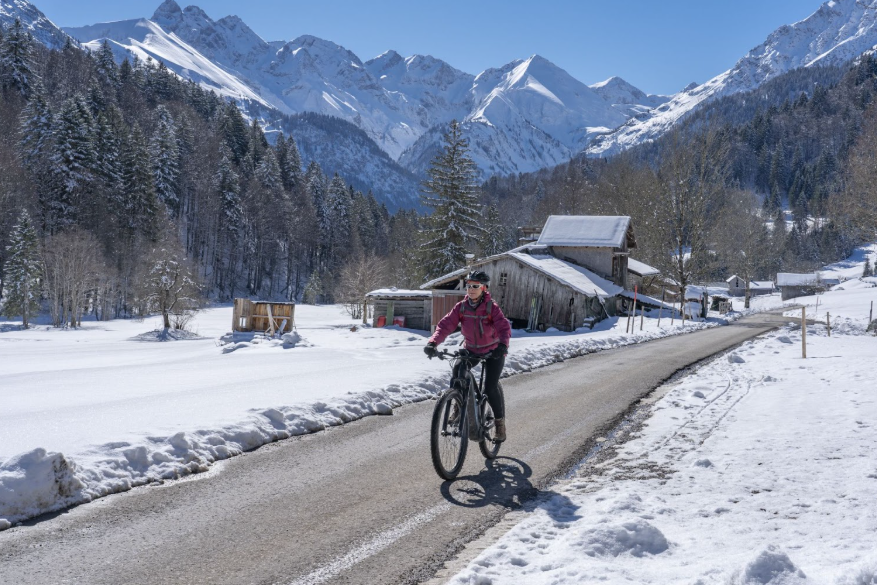Winter Cycling Tips to Extend Your Riding Season

Nothing kills mid-ride joy faster than the sting of frozen fingers. Many riders resign their bikes to the garage once temperatures tumble, but with smart prep and the right gear, you can keep cranking all season.
Below are proven tips to help you stay warm, safe, and motivated long after the leaves have fallen.
Master Layering for Winter Rides
Great winter rides start with the right fabrics in the proper order. The key is to manage moisture and trap heat without creating excessive bulk that restricts movement.
Base Layer (Moisture Management)
Choose lightweight merino wool or synthetic polyester, which wicks moisture away from the skin to keep you dry and prevent chilling. A snug fit helps pull sweat away from the skin to optimize moisture management and comfort during exertion.
Mid Layer (Insulation)
Use a thermal jersey, lightweight fleece, or insulated vest that traps warm air close to the body while avoiding excessive bulk. The mid layer provides essential thermal regulation by maintaining core warmth during colder temperatures.
Outer Layer (Weather Armor)
Select a wind-blocking soft shell or waterproof breathable jacket that shields against wind, rain, and snow. Features like vents or two-way zippers allow heat to escape on climbs, preventing overheating.
Layering must balance warmth and ventilation. Overheating leads to sweating, which then chills when activity slows. Removing or adding layers efficiently is key, though challenging for cyclists moving at speed.
Most cyclists manage temperature dynamically by adjusting effort levels and using layers suited to current exertion and conditions rather than frequent stops to change clothes.
Carrying compact extra layers for breaks or changing weather helps maintain comfort and safety.
Invest in the Best Winter Cycling Gear
Beyond layering, specific gear is essential for protecting your extremities and ensuring you are visible during the shorter daylight hours of winter. Don’t let cold weather cut your riding season short.
Here’s what you need to stay warm and visible on winter roads:
- A thermal skull cap that fits comfortably under a helmet
- Clear or amber lenses for your glasses to improve visibility in low sun
- Windproof shoe covers or dedicated insulated winter boots
- High-lumen lights for both the front and rear of your bike
Keep Your Hands Warm
Hands often suffer first because they’re exposed and have little muscle mass to generate heat. Manual dexterity can drop significantly when your skin temperature falls below 50°F (10°C), making braking and shifting clumsy on slick roads. Quality gloves are non-negotiable for winter riding.
Exploring different types of battery-powered heated gloves from Weston Store can help you understand the technology available for persistent colds. They use battery-powered heating elements that run along the fingers and back of the hand. You can adjust the warmth with multiple heat levels to stay comfortable without sweating.
Here are the key features to look for:
- Fit: Choose a snug but not tight fit, as air gaps can create cold spots
- Battery: Removable packs are ideal for long rides, allowing you to carry spares
- Charger: Look for modern charging standards like USB-C for convenience
- Cuff Design: Ensure the cuff is long enough to tuck inside your jacket, sealing out wind
Prep Your Bike for Winter
Your bike needs a few adjustments to handle winter conditions safely. A little preparation goes a long way in preventing mechanical issues and improving your stability on compromised surfaces.
Tires
For better grip, choose 2–4 mm wider than your summer tires and reduce the pressure by 10–15 psi to increase the contact patch and improve traction on snow and ice. Thicker tires with deeper tread or even studded tires provide additional grip in icy conditions.
Fenders
Full-coverage fenders are invaluable for keeping slush, mud, and road grime off your drivetrain and body. They help prevent corrosion and keep you cleaner during winter rides. Installing fenders can also improve safety by minimizing water spray that could reduce visibility for you and others.
Lights
Use daytime-running or bright front and rear lights with reflectors to boost your visibility during the low winter sun and cloudy days. Battery performance can drop in cold weather, so carry extra batteries and check the light function before each ride.
Corrosion Prevention
Wet roads and road salt accelerate rust on your chain, gears, and other metal parts. After every sloppy ride, wipe down, dry, and apply wet lube (which better resists water) to your chain. Regular cleaning and lubrication help extend bike life and maintain smooth operation during winter.
Winter riding demands a more cautious and deliberate approach. Your summer habits may not translate well to cold, wet, or icy roads.
- Smooth Cadence: Spin in an easier gear rather than mashing a hard one to be gentler on cold joints.
- Slow Cornering & Brake Early: Black ice often hides in shaded bends and on bridges.
- Route Planning: Favor sun-exposed roads in the morning and, if possible, plan for a tailwind on your way home.
Mastering these adjustments will help you ride confidently through even the harshest winter conditions.
Prioritize Safety & Comfort En-Route
Staying comfortable and safe during the ride is as important as your initial preparation. Pay attention to your body and your surroundings.
- Visibility: Reflective bands on your ankles and daytime flashers on your bike are cheap insurance.
- Hydration: Cold air can blunt your sense of thirst, so remember to sip every 15 minutes. Use insulated bottles to keep drinks from freezing.
- Break Strategy: Short “espresso stops” are better than long cafe breaks, which can cause your core temperature to drop.
Minor adjustments during your ride can prevent bigger problems from developing miles from home.
Stay Motivated All Winter
Getting out the door is often the most challenging part of a winter ride. Setting up systems to keep yourself accountable can make all the difference.
- Micro-Goals: Aim to ride three times a week or hit a certain monthly distance.
- Winter Buddy: Having a friend to ride with doubles your chances of both showing up.
- Celebrate Milestones: Post frosty-ride photos or track your progress on an app to gamify your winter season.
For example, a commuter might find that solving the problem of cold hands makes a drizzly 38°F ride feel much more manageable. Once a key discomfort is removed, the motivation to ride year-round often follows.
Common Winter Cycling Mistakes to Avoid
Even experienced riders can make simple mistakes when the temperature drops. Avoiding these common pitfalls will make your rides safer and more enjoyable.
- Over-Dressing Early, Freezing Later: Always start your ride feeling slightly cool, as you will warm up.
- Wearing Cotton Layers: Cotton traps sweat against your skin, making you cold.
- Ignoring Wind Chill: A 25 mph descent can turn a 35°F day into a 24°F real-feel temperature.
- Chain Neglect: Road salt is highly corrosive; regularly clean and lube your chain.
- Skipping Hand Protection: A single ride with painfully numb fingers can ruin your confidence for the rest of the season.
Recognizing these pitfalls before they happen separates prepared cyclists from those who learn the hard way.
Embrace the Cold and Ride On
Winter cycling doesn’t have to be an exercise in suffering. Combine layering with a properly prepped bike and upgraded gear to transform icy chores into crisp, rewarding adventures. Pick one tip from this guide and test it this week; you might unlock a longer riding season and newfound cold-weather confidence.

